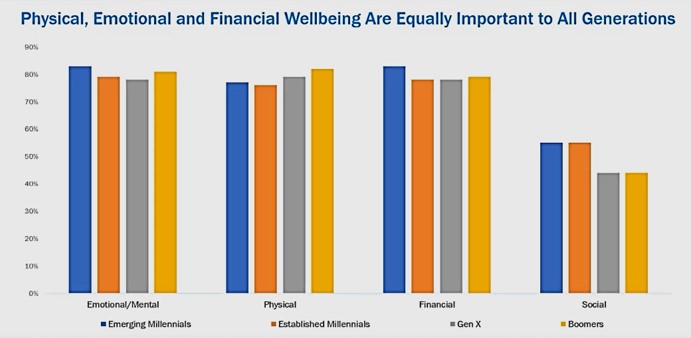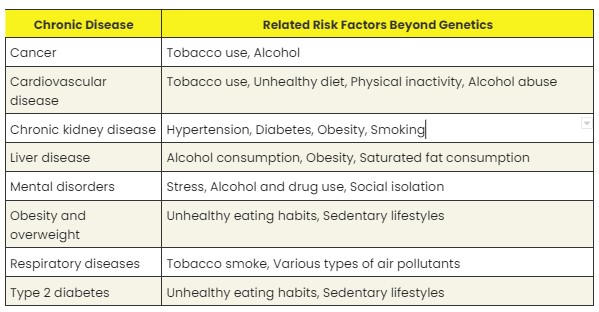
Wellness matters to everyone in your organization. Should we be surprised? Wellbeing is vital to health and happiness. When we feel strong and well-adapted, we’re better able to prevail over adversity and achieve our goals. But wellbeing goes way beyond the absence of disease. In short, being well enables us to show up as the best version of ourselves every day. It fuels our bodies, engages our minds, and renews our spirits.
Psychologists identify as many as nine dimensions of wellbeing, but for today we’ll focus on the four most commonly addressed in a corporate culture of health: mental, physical, financial, and social.
1. Mental wellbeing
The World Health Organization’s concept of mental wellbeing is clear: “Mental health is not just the absence of mental disorder. It is defined as a state of wellbeing in which every individual realizes his or her own potential, can cope with the normal stresses of life, can work productively and fruitfully, and is able to make a contribution to her or his community.” Key to this is helping employees to de-stress, face addiction, and ease their workloads so that they can reach their full potential.
2. Physical wellbeing
Impaired physical wellbeing is typically easier to spot than impaired mental wellbeing – no matter whether this is ailing health, obesity, or experiencing physical pain. But sometimes employees don’t even know they are physically ill, so managers and HR teams need to grasp the wider picture in order for employees to achieve their optimal level of physical wellbeing. It’s also vital to address working environments that impede physical wellbeing – from the office to the warehouse.
3. Financial wellbeing
Recent research by The Hartford has determined that 63% of U.S. employees sense their financial stress worsened over 2022, and 56% of them say financial stress adversely impacts their mental health. This is true among all generations, but especially younger workers who often live paycheck to paycheck. Nearly half of Boomers (45%) worry that they have no retirement savings. And because many employees have difficulty discussing these kinds of issues, financial problems often go unaddressed. Isolating root causes of poor financial wellbeing can be thorny and complex for HR and management, but they need to address it for all generations.
4.Social wellbeing
The ways in which employees interact with each other impacts both mental and emotional wellbeing. Returning to the workplace after months of Covid furloughs or home office employment has led to frustration, soaring stress levels, and burnout. Employees may feel reluctant to have in-person interactions with colleagues that not long ago were over Teams or Zoom. The change can provoke anxiety and upset, as well as conflict. Supporting your employees’ social wellbeing fosters both their success and that of the larger organization. When you show employees that you value social wellness, you will encourage collaboration and conflict resolution.
Notice from the chart below that all four aspects of well-being (mental, physical, financial, and social) remain fairly even among all of the generations.

From Zoomers to Boomers, all rank social well-being as less important than mental, physical, and financial well-being. That doesn’t mean ignoring this aspect of wellness. In fact, researchers have found through examining multiple recent studies that loneliness is likely to reach epidemic proportions in the Western world by 2030 – outstripping obesity as the number one health crisis. Combating social isolation in the workplace should be a high priority for any wellness initiatives.
What other similarities do generations share?
50 years ago, young people entering the world of work were generally healthy. Today, given sedentary lifestyles and poor eating habits, Millennials and Zoomers increasingly join the workforce with chronic health conditions. Recent CDC data confirms that more than half of young adults (nearly 54%) now have at least one chronic medical issue, and more than one in four (27%) suffer from two or more chronic health conditions. The below isn’t an exhaustive list of chronic health conditions or their risk factors beyond genetics by any means, but these conditions are commonly found among employees:

Chronic Disease-Related Risk Factors Beyond Genetics
Will workplace wellbeing programs end all chronic diseases for any of your generations? Sadly, no. Many chronic health conditions are due to genetic factors. But here’s the thing…optimal sleep, stress reduction, diet, and exercise mitigate all these illnesses, genetic or not. And employees who feel better work smarter and harder and are absent less often. Plus, when you consider that all the risk factors for chronic disease outside of genetics are largely preventable, providing corporate wellness services to your workers is a no-brainer, regardless of what generation they fall into.
To your health!
Derek

